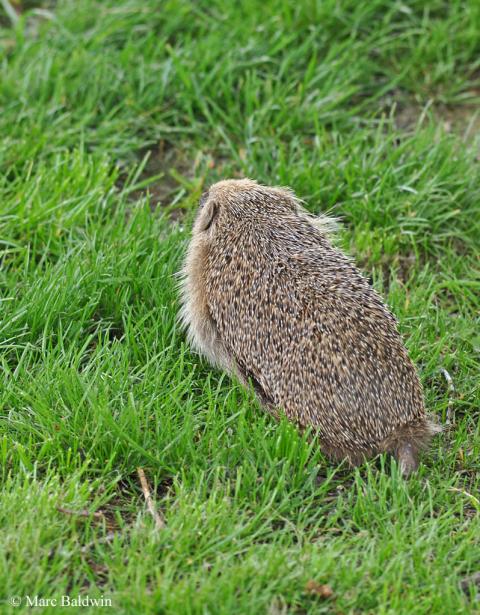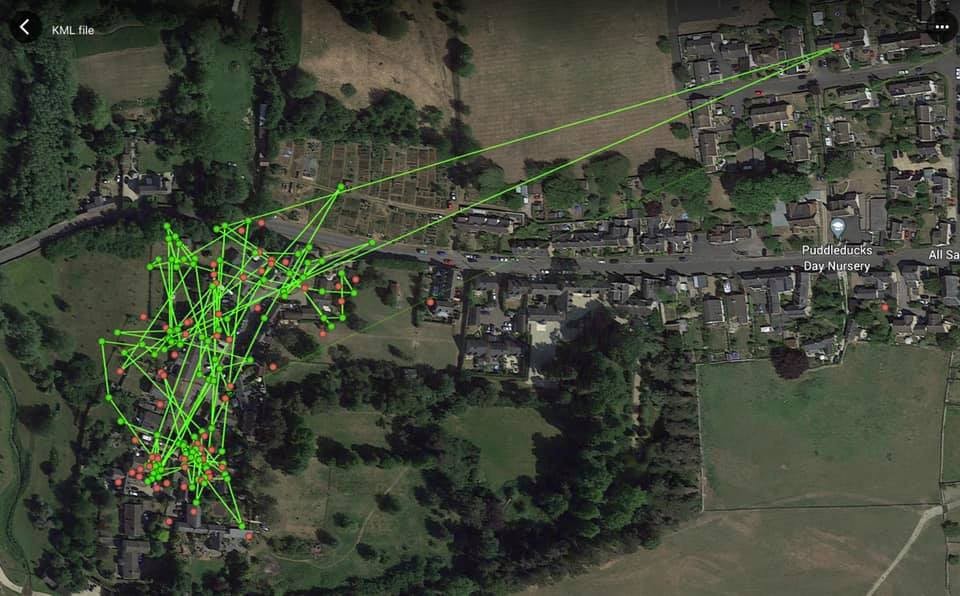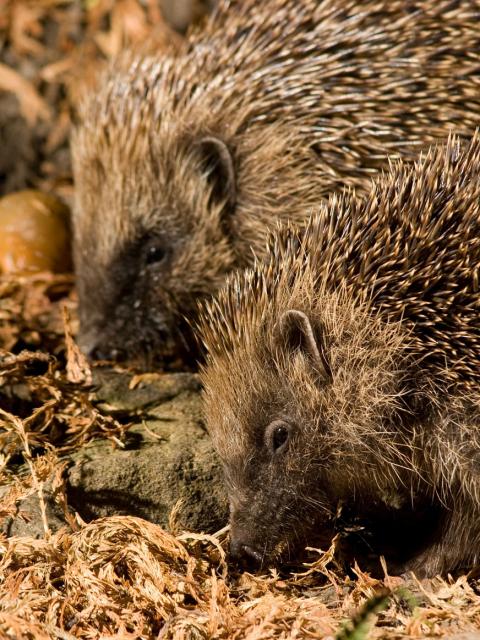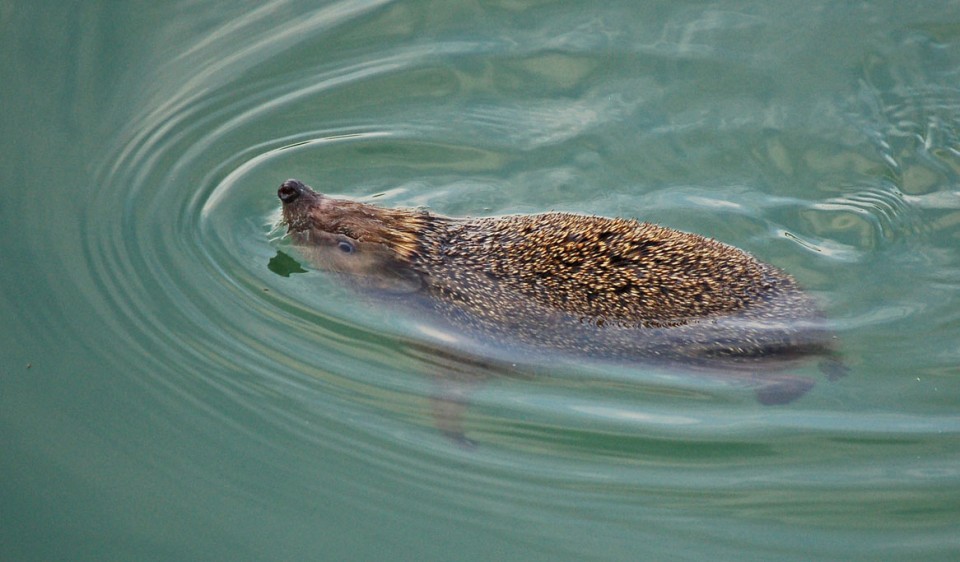European Hedgehog Activity
Hedgehogs are more active and range further than many people realise. Populations also appear to mix well, in connected habitats, and hog-lovers who have tagged their 'resident hog' have been surprised to find what they thought was one hedgehog visiting their garden was actually a dozen or more different individuals. This has been our experience, too. What we thought was "four or five" hedgehogs visiting turned out to be, at the point of writing in October 2020, 15 individually recognisable animals (plus at least two un-marked males) when we started marking their spines with a small blob of water-based paint. A more impressive record is held by Odian Samson, who marked 47 different hedgehogs visiting his garden on Jersey over one year.
In his 1988 Shire book The Hedgehog, Pat Morris wrote that the bulk of mark-recapture studies have been carried out by amateur naturalists, which means that they are rarely long-term or particularly systematic. They nonetheless provide a valuable insight into population dynamics in that few are recaptured, suggesting, as we have found, while a few are regulars (we only see about four with any regularity), most either wander widely or are nomadic. Certainly, our records anecdotally suggest that some individuals appear almost every night while others are absent for several days. "Hog2", a female, for example, is sometimes absent for three or four days at a time, while "Hog3" and "Hog4", both males, have disappeared for much longer periods. Hog3 was away for 10 days in early June 2020 and a further 18 days spanning the end of June and start of July, while, between late May and mid-June, Hog4 was around almost every day, before disappearing for four days, coming back for a couple of days and was then absent for two weeks before reappearing on the trailcams in late July. We've also observed far fewer visits during nights of heavy rain, although whether this reflects a genuine reduction in activity during inclement weather, or that there are lots of worms and beetles around to distract and delay them, remains unknown. Regardless, as we shall see shortly, more recent tracking studies have supported some of these cursory findings.

Hedgehogs are primarily nocturnal, waking around dusk to forage throughout their home range. Precisely how long hedgehogs are active for during a night varies according to location, sex and season. On their West London golf course, for example, Nigel Reeve and Pat Morris found that lactating females were active constantly throughout the night, although in his New Hedgehog Book, Morris notes that hedgehogs "can do nothing for hours on end".
Observations in captivity have documented bimodal peaks in their activity: the main period of activity is between about 10pm and midnight, with a smaller peak around 3am. Some data collected from field studies support this general activity pattern, although the periods are less well defined and bimodal patterns are not universally accepted. Despite this, in Hedgehogs, Nigel Reeve wrote:
"... with regard to general activity, I found that the animals were active throughout the night and their speed of movement varied erratically with no apparent rhythmicity. Animals only occasionally took short rests (not in a nest) at various times during their nocturnal excursions."

The availability of food is likely to be a significant factor in whether activity peaks are seen. Dietary studies have shown that hedgehogs consume between 57g and 71g (2 - 2.5 oz.), which represents about 20% of their body weight, per night; but Derek Yalden has demonstrated that a tightly-packed hedgehog stomach only holds around 32g (just over 1 oz.) of food. The theory is that if the hog can fill its stomach early in the evening it may rest and digest its meal before continuing to forage, therefore filling its stomach twice per night, while those who are less able to find food early will forage continually throughout the night. Indeed, hedgehogs may be found resting among vegetation away from their nest periodically during the night, and I have seen many videos from "feeder cams" showing a hedgehog curling up in the feeding station to for a nap after eating its fill of biscuits, on one occasion even sleeping in the half-full bowl of biscuits.
Across most of their range, hedgehogs are active for approximately eight months of the year (April to November), although this varies considerably according to the prevailing climatic conditions and thus latitude. In the milder regions of New Zealand, North Island for example, hogs are active all year around or hibernate for only a couple of months, because the climate is warm and allows them access to food for 365 days -- in cooler areas, torpor can be from July to October. At latitudes where cold winters lead to food shortages, hedgehogs enter a torpid state referred to as hibernation. In the UK, hedgehogs are generally putting the finishing touches to their hibernacula (see Nests & Hibernacula) by the beginning of autumn, although larger individuals may not to settle down until November; later in mild winters.
In his Complete Hedgehog, Les Stocker noted how, in the UK, hedgehogs seem to 'prefer' to wait until at least November before hibernating, and that small hedgehogs seem to know that they don't have sufficient fat reserves to survive hibernation; consequently, they're seen out at all times of the day and night searching for food. Hibernation is not a continuous process and hedgehogs will arouse periodically, particularly during very cold weather; they may leave the nest briefly or even build a new one. Indeed, in the Atlas of British Mammals, published in 1993, about 6% of the 1,688 records of hedgehogs killed on the roads between 1960 and 1992 were from October onwards, with some from January and February. Similarly, Pat Morris found that just over 11% of the 992 reports of hedgehogs killed on the roads in London between 1956 and 1964 were in November and December; 32 animals were recorded between January and March.
Movements while foraging
Hedgehogs forage at the woodland edge, under hedgerows, over pasture and along beaches at low tide as well as in gardens, parks, playing fields and even refuse tips. On farmland, they can often be found feeding at dung heaps near livestock sheds, owing to the number and diversity of invertebrates such locations attract. Most tracking studies suggest that hedgehogs tend to remain close to linear features, particularly hedges, while foraging. Work by Amy Haigh and colleagues in Ireland suggests that they're primarily attracted to areas with high numbers of prey, and hedges with good ground cover act as an ideal reserve for invertebrates. Haigh and her team nonetheless observed hedgehogs feeding out in the middle of fields, well away from cover, in areas with high invertebrate counts. Interestingly, Carly Pettet and colleagues, tracking hogs in Norfolk and Yorkshire, found that hedgehogs were likely to be found further from cover on cold nights, which is contrary to what we might expect given how poorly insulated they are. The suggestion is that the invertebrates that are the main prey of hedgehogs are scarce in cold weather, forcing the hogs to move further afield in search of enough.
Tracking studies by Pat Morris and Nigel Reeve have demonstrated that hedgehogs do not follow a specific route while foraging, nor do they visit specific gardens where they know they're going to be fed first (as foxes and badgers are known to). At the same time, hedgehogs don't wander randomly about their range. Instead, they travel a meandering path, frequently speeding up or stopping altogether to sniff the air and the ground; they have a good sense of direction and impressive homing skills.
As they forage, hedgehogs are constantly alert and any prey is readily snapped up with quick darting movements. During his Ph.D. thesis on hedgehog feeding ecology, Andrew Wroot found that, while foraging, 70% of a hedgehog's movements are very short; there were very few bursts of rapid long distance movement where a hog would seemingly 'chase down' prey. Experiments with captive hogs suggest that dead or moribund prey is either ignored or sniffed for a considerable time prior to being consumed,while active prey is consumed immediately and may be 'pounced upon' from up to 50cm (1.5 ft) away. Buried food, especially earthworms (which are eaten tail-first) and beetles, can be detected under some three centimetres (about an inch) of soil and is dug up using front paws. Hedgehogs don't appear to dig very deep for prey, although in The Hedgehog Maurice Burton talks of "three-inch holes on lawns where a hedgehog has been digging out leatherjackets".
Wroot's data also showed that foraging speed was heavily influenced by the percentage of cover. The type of cover also affects the speed of travel; movements across open grassy areas tend to be faster than those through denser undergrowth.This may be a consequence of both impedance (i.e. it is physically more difficult maneuvering through dense bramble than short grass) and the potential of predation where a hog is more vulnerable to predation out in the open. Hedgehogs can also move rapidly if the need arises. Reeve clocked one doing 60 metres per minute (just over 2 mph) across open grassland, while Wroot recorded one travelling at 120 m per min (almost 4.5 mph) and, in his 1969 book, Maurice Burton described how he couldn't keep pace with a hedgehog by walking and had to break into a trot, implying a speed more than 80 metres per minute (3 mph). Sprinting feats aside, the average speed at which hedgehogs travel is typically between two and four metres per minute (6.5 to 13 ft. per min); on average males appear to travel faster (3.73 m per min) than females (2.19 m per min).

Foraging hedgehogs move further than many people imagine, visiting many different gardens in a single night -- having connected gardens with holes in fences to allow the free passage of wildlife is therefore critical. The distance travelled on any given night is related to the habitat, and specifically how much food that habitat provides; hedgehogs in good quality mixed farmland and urban areas, where food is more abundant, range less than those in poorer pasture/grassland habitats, for example. On average, however, male hedgehogs move further than females on a nightly basis; about 2km (just over a mile) and 1km (about 0.5 mile), respectively. In Hedgehogs, Nigel Reeve reports that the current British record for a radio-tracked hedgehog to travel in a single night is 3.14 km (nearly 2 miles).
How they spend their time
Much of our information regarding how hedgehogs spend their time comes from radio-tracking studies. Radio-tracking (and GPS tracking) undeniably provides a wealth of valuable data, but it can really only tell you where an animal is at a given time and whether it is moving or stationary (in some instances, physiological data can be collected too); we have no idea what the animal is actually doing. When its stationary, is it feeding, resting, grooming etc.? Consequently, in order to really understand how hedgehogs spend their time, we must couple radio-tracking data with direct observation. Nigel Reeve and Andrew Wroot did just this as part of their studies on the hedgehog population from a West London golf course -- they conducted 'spot checks' on the hogs they were tracking.

Pooling their data, it transpires that the hedgehogs spent 40% to 55% of their waking hours foraging, with only 10% of their time standing still with no obvious goal (i.e. they weren't standing while eating or grooming); 4% was spent on courtship and only 2% or 3% meeting other hogs and/or grooming. Correcting for the time spent in private gardens where they were inaccessible to the researchers, Wroot suggested that, overall, hedgehogs probably spend 68% to 84% of their time foraging. A similar study by Amy Haigh in Ireland, published in Mammalia in 2013, observed 35% of time spent in courtship and only 29% foraging from May to July; breeding stopped in August and foraging then accounted for 66% of their time.
A study in an urban area of Bristol, led by Claire Dowding, revealed that hedgehog movements were associated with weather conditions and the risk of encountering a predator or car. In a fascinating paper to the journal Animal Behaviour during 2010, Dowding and her team report that the 38 hedgehogs (19 of each sex) that they tracked between May and September 2004 and 2005 preferentially used the gardens of semi-detached and terraced houses, but that females avoided the larger back gardens of detached houses, which were also popular with badgers. Interestingly, the males showed no such preference, which the authors put down to differences in breeding behaviour between the sexes. The hedgehogs also avoided foraging near roads and on road verges, although didn't avoid crossing roads -- males were, however, more prone to crossing roads than females. The hogs were significantly more active after midnight, when there were fewer cars and people around. In 2013 and 2014, Carly Pettet and colleagues at the University of Oxford's Wildlife Conservation Research Unit tracked 78 hedgehogs at four sites in England, two in Norfolk and two in north Yorkshire. The data from their study, published in the European Journal of Wildlife Research during 2017, showed how the hedgehogs preferred to use gardens for foraging, and where badgers were present the hogs remained closer to cover. In badger territories, hog home ranges were, on average, 12 hectares (30 acres) smaller than in badger-free locations, although the researchers do point out that the higher density of food in villages allows for smaller ranges regardless of predators.
Ain’t no mountain high enough …
Hedgehogs are deceptively good climbers with apparently little fear of either heights or falling. In his 1969 book The Hedgehog, Maurice Burton recounts various examples of hedgehogs having been seen climbing wire fences and trees with only slightly sloping trunks, walking along the top of walls and curled up asleep in drainpipes. In one particularly surprising account, Burton recalls how a hedgehog was found asleep in the pocket of a farmer's trousers that had been left to dry hanging above a hot pipe leading to the kitchen stove; apparently the lowest point of the trousers was several inches from the floor.

They're also good swimmers; several tracking studies have recorded them crossing rivers and in his 1910 A History of British Mammals, Gerald Barrett-Hamilton wrote of the hedgehog:
"As a swimmer its proficiency at least equals its needs, and it must be at times capable of considerable achievements in this direction. Mr Cocks once knew one to land at Great Marlow after a swim in the Thames, which must have extended, probably down stream, for some hundreds of yards. Mr Millais has drawn one in the water; the animal is immersed deeply, with back, eyes, and snout just above the surface."
In his field notes to the magazine Countryside in 1987, J.M. Potter described a hedgehog crossing a stream that had become a raging torrent after heavy rains; swimming powerfully across the fast-flowing water and shaking itself like a dog upon climbing out the other side. The ITV documentary Hedgehog Hotel, aired in 2015, featured some slow-motion footage of a hedgehog shaking in this manner, with spines rattling - the rattling noise from this is audible from several metres away in my experience. Sometimes, hedgehogs appear to take to water a little too enthusiastically. Pat Morris has written of having to wade into the water in the dark to rescue a hedgehog he was tracking that had gotten rather over ambitious and decided to swim across a millpond. Similarly, in Hedgehogs Morris tells how he had to take off his clothes and swim out to rescue a hedgehog that was swimming in circles in a lake in New Zealand for a good 10 minutes, watched by some bemused scaup. These observations suggest hogs may have difficulty judging distances across water.

Stay away from the light?
In 2019, just shy of 2,900 people from across the UK responded to the BBC Gardeners' World garden wildlife survey. Of those who had hedgehogs visiting, 60% reported having seen them during the daytime, although only 10% of English and Welsh and 6% of Scottish and Northern Irish respondents regularly saw them in daylight. It is widely maintained that any hedgehog seen out during the daytime is sick and requires capturing and veterinary attention. While is is often the case, and as a broad rule of thumb it errs on the side of caution, it is not always the case. Let's be clear, though: any hedgehog found out in the open during the daytime or stumbling, coughing, listless (e.g. "sunbathing" or curled up away from cover), moving with the body held high ("walking tall"), or otherwise in distress during the day or night should be seen by a hedgehog carer or vet as soon as possible. Simply being out in daylight is not, on its own, necessarily an indication that anything is wrong, particularly if it is for a short period and the hedgehog remains in cover. Indeed, on our trailcams, and those of several other observers, it is relatively common for hedgehogs (curiously all males in the cases of which I'm aware) to leave their hog house/nest during the morning to defaecate nearby, and often drink, before returning to bed.

The most obvious cases where people see hedgehogs out in daylight are shortly before dusk and after dawn, particularly during the summer when nights are short. It is not uncommon for hogs to be out and about a couple of hours before sunset and after sunrise between June and August. Disturbance of a daytime resting site may result in the hedgehog moving somewhere else, and a female may move her hoglets to a new nest in daylight. My experience and that of a couple of hedgehog rescues I have spoken with suggests that hedgehogs will also leave nests if it gets very hot to find somewhere cooler to sleep. Similarly, mothers may leave the nest to get some time away from the hoglets or, in the case of lactating sows, find additional food and water. In a Russian study during which hedgehogs were radio-tracked around Kalinin, north-west of Moscow, one lactating female was observed to be active for equal periods of the day and night. Pregnant females may also collect nesting material during the day.
Newly independent hoglets will often venture out during the day and it is not uncommon to encounter juvenile hogs in gardens during July afternoons. Hedgehogs born later in the year (the so-called "autumn orphans") may be seen out in daylight trying to build sufficient fat reserves to allow hibernation despite being otherwise healthy, although these are quite likely to need intervention. It should also be noted that young hedgehogs out during the day are vulnerable to predators, particularly cats, foxes magpies and gulls.
There are also specific locations where hedgehogs show an increasing tendency towards diurnal (daytime) activity. On the Isle of Mull, for example, hogs are frequently seen out foraging during the day, possibly reflecting a lack of predators.
Finally, from the data we have on the influence of artificial lighting on hedgehog activity, it seems that they're largely unconcerned -- or at least they readily adapt to it. In their assessment of the impact of road lighting on hedgehog crossings, Johannes de Molenaar and colleagues found no significant difference between crossings made on lit and unlit stretches. Similarly, Fiona Mathews and colleagues, in their collaborative study with The Mammal Society, found that hedgehogs weren't dissuaded from using feeding stations lit by artificial light at night. My own experience has been that hedgehogs often avoid direct bright light, preferring to move around the periphery, but can become readily accustomed to it. I have also noticed, both in our garden and in footage from other people's, that hedgehog out around dawn/dusk will adopt a low-slung "slinking" movement, perhaps indicating that they feel more vulnerable in higher light levels when they can hear daytime noise (e.g. magpies calling or machinery).
My personal view is that a hedgehog out in the day is not immediately a matter for concern. While it is not always easy to tell, given how good wild animals are at masking sickness, if the animal is moving briskly and with purpose, keeping to cover, collecting bedding, going for a drink or moving hoglets, for example, I would be hesitant to intervene. If the animal is foraging or curled up away from cover, unsteady, wandering aimlessly, disorientated, curled up away from cover, or lying out "sunbathing", then I reach for the gardening gloves and high-sided box. If in doubt, please call your local wildlife rescue who will be able to provide guidance based on what you've observed and your local conditions. As Nigel Reeve put it in Hedgehogs, though:
"It seems that although hedgehogs 'prefer' to be nocturnal, it is clearly not obligatory."